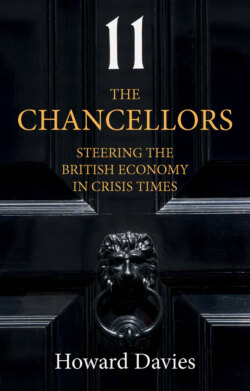The Chancellors

Реклама. ООО «ЛитРес», ИНН: 7719571260.
Оглавление
Howard Davies. The Chancellors
CONTENTS
Guide
Pages
The Chancellors. Steering the British Economy in Crisis Times
Abbreviations
Introduction
Notes
1 Economic Performance
1997–2010: The Brown years
2010–16: The austerity years
2016–20: The EU Referendum and after
Beyond Covid
Notes
2 Macroeconomic Policy
Notes
3 Public Expenditure
Brown One: Married to Prudence
Brown Two: Prudence jilted?
Darling and the financial crisis
Osborne: The austerity Chancellor
The Hammond years
Javid’s short-lived rules
Sunak: Covid-19
Notes
4 Tax Policy
Labour and tax: 1997–2010
Coalition and Conservatives: 2010–21
The Mirrlees Review
Why is tax reform so difficult?
Notes
5 Scotland: Saving the Union
Notes
6 Europe: The Ins and Outs
The euro: failing the tests
Semi-detachment
The EU referendum: Project Fear
Brexit and after
Notes
7 Financial Regulation and the City of London
The Financial Services Authority
The New Bank of England
The gathering storm
All hands to the pump
Financial regulation after the crisis
Brexit and the City
Notes
8 Climate Change and the Road to Net Zero
Notes
9 The Treasury’s Changing Shape
Setting the Bank free
John Birt’s teddy bear
Structural changes
Feeble threats
Does size matter?
Cheap but cheerful?
Call a spad a spad
Culture
Notes
10 Leadership
Gordon Brown
Alistair Darling
George Osborne
Philip Hammond
Sajid Javid
Rishi Sunak
Other ministers
Permanent Secretaries
Notes
11 Trouble Ahead
1. The Treasury View
2. Monetary and fiscal policy
3. Public finance post-Covid
4. Tax policy
5. Levelling up
6. Climate change
7. Productivity
Notes
Index. A
B
C
D
E
F
G
H
I
J
K
L
M
N
O
P
Q
R
S
T
U
V
W
POLITY END USER LICENSE AGREEMENT
Отрывок из книги
Howard Davies
The period covered ran from 1974 to 1997. Aside from the personal availability, there was a certain policy logic in that it began with Healey’s attempt to establish budget discipline and control inflation, after the International Monetary Fund (IMF) visitation in 1976. Healey introduced the monetary framework which Howe made the centre of his policy. The period ended with the 1997 election, immediately after which Brown handed control of interest rates to an independent Bank of England.
.....
The crisis was, however, extremely severe. The economy shrank by more than 6% between the first quarter of 2008 and the second quarter of 2009, and took five years to recover fully. Unemployment, always a lagging indicator, rose from 5% to 8.4% by the end of 2011. The government’s deficit reached 7% of GDP in 2009 and was still 5% in 2010. Real incomes fell sharply in 2009 and did not begin to rise sustainably until 2015. With household, business and financial debt at 420% of GDP, the UK was the most highly indebted developed country in the world.
That was the difficult background against which the Coalition government was formed in May 2010. George Osborne, who had been Shadow Chancellor since David Cameron became leader of the Conservative Party in 2005, was the inevitable choice for 11 Downing Street. The complex negotiations over the leading positions in government led to the appointment of Liberal Democrat MP David Laws as Chief Secretary to the Treasury (CST), soon replaced by Danny Alexander, making him an unusually powerful holder of that post, as one of the ‘Quad’ of key decision-makers in the government.
.....